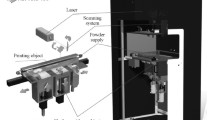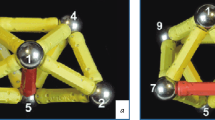Experimental results of microstructural studies of refractory nickel alloys obtained by selective laser melting under different crystallization conditions are systematized. The dendritic (cellular) structure and the distribution of the alloying elements in the volume of dendrite arms are studied by scanning and transmission electron microscopy. The detected microsegregation matches a normal crystallization law and is caused by concentration supercooling. It is shown that the main factors responsible for formation of the fine structure of a track are the orientation growth (epitaxy) and the competitive growth of crystallites. The orientation of the crystallites is transferred not only by the first-order arms but also by the second-order arms, and a specific direction is implemented upon coincidence of the crystallographic orientation of the crystallite with the radial direction of the heat removal. The increasing complexity and the fragmentation of the fine structure are associated with the mechanism of stochastic binarization of the crystallographic orientation implemented upon partial remelting and opening of fragments of cells in the current and preceding layers.










Similar content being viewed by others
References
S. N. Aristov, E. Yu. Polyakov, and L. F. Spevak, “Nonstationary Benard-Marangoni convection of lamellar flows of viscous incompressible fluid,” Teor. Osn. Khim. Tekhnol., 50(2), 137 – 146 (2016).
A. N. Aristov and K. G. Shvarts, Vortex Flows of Advective Nature in Rotating Liquid Layer [in Russian], Perm. Univ., Perm (200), 155 p.
A. N. Aristov and K. G. Shvarts, Vortex Flows in Thin Liquid Layers [in Russian], VyatGU, Kirov (2011), 207 p.
K. G. Shvarts, “Plane-parallel advective flow in horizontal layer of incompressible liquid with solid boundaries,” Izv. Ross. Akad. Nauk, Mekh. Zhidk. Gaza, No. 4, 26 (2014).
Saad A. Khairallah, Andrew T. Anderson, Alexander Rubenchik, and Wayne K. King, “Laser powder-bed fusion additive manufacturing: Physics of complex melt flow and formation mechanisms of pores, spatter, and denudation zones,” Acta Mater., 108, 35 – 46 (2016).
B. Xiao and Y. Zhang, “Marangoni and buoyancy effects on direct metal laser sintering with a moving laser beam Numerical,” Heat Trans., Pt. A, 51, 715 – 733 (2007) *
H. J.Willy, “Modelling thermal capillary effects and flow in the molten pool during selective laser melting,” in: Proc. COMSOL Conf., Singapore (2018), p. 18.
T. Pinomaa, I. Yashchuk, M. Lindroos, et al., “Process-structure-properties-performance modeling for selective laser melting,” Metals, No. 9, 1138 (2019).
Zhaowei Xiang, Ming Yin, Guonhua Dong, et al., “Modeling of the thermal physical process and study on the reliability of linear energy density for selective laser melting,” Results Phys., No. 9, 939 – 946 (2018).
C. Panwisawas, Y. Sovani, M. J. Anderson, et al., “A multi-scale multi-physics approach to modelling of additive manufacturing in nickel-based superalloy,” in: Superalloys 2016, Proc. 13th Int. Symp. on Superalloys (2016), pp. 1021 – 1030.
K. Antony and N. Arivazhagan, “Studies on energy penetration and Marangoni effect during laser melting process,” J. Eng. Sci. Technol., 10(4), 509 – 525 (2015).
T. M. Wischeropp, R. Salazar, D. Herzog, and C. Emmelmann, “Simulation of the effect of different laser beam intensity profiles on heat distribution in selective laser melting,” in: Proc. Lasers in Manufacturing Conf. 2015 (electronic resource); https://www.wlt.de/lim/Proceedings2015/Stick/PDF/Contribution304 final.pdf.
M. Letenneur, A. Kreitcberg, and V. Brailovski, “Optimization of laser powder bed fusion processing using a combination of melt pool modeling and design of experiment approaches: density control,” J. Manuf. Mater. Proc., 3(21), 1 – 13 (2019); doi: https://doi.org/10.3390/jmmp3010021.
X. Zhou, Y. Zhong, Zh. Shen, and W. Liu, “The surface-tension-driven Benard conventions and unique sub-grain cellular microstructures in 316L steel selective laser melting”, Appl. Phys. Mater. Sci. (2018) (electronic resource); https://arXiv:1801.01408v1. https://doi.org/10.48550/arXiv.1801.01408.
K. Saeidi, X. Gao, Y. Zhong, and Z. J. Shen, “Hardened austenite steel with columnar sub-grain structure formed by laser melting,” Mater. Sci. Eng. A-Struct., 625, 221 – 229 (2015).
I. Yadroitsev, P. Krakhmalev, I. Yadroitsava, et al., “Energy input effect on morphology and microstructure of selective laser melting single track from metallic powder,” J. Mater. Proc. Technol., 213, 606 – 613 (2013).
I. Hemmati, V. Ocelik, and J. T. M. Hosson, “Microstructural characterization of AISI 431 martensitic stainless steel laser-deposited coatings,” J. Mater. Sci., 46, 3405 – 3414 (2011).
H. E. Cheikh, B. Courant, S. Branchu, et al., “Direct Laser Fabrication process with coaxial powder projection of 316L steel. Geometrical characteristics and microstructure characterization of wall structures,” Opt. Laser Eng., 50, 1778 – 1784 (2012).
J. T. McKeown, A. K. Kulovits, C. Liu, et al., “In situ transmission electron microscopy of crystal growth-mode transitions during rapid solidification of a hypoeutectic Al – Cu alloy,” Acta Mater., 65, 56 – 68 (2014).
Y. Guan,W. Zhou, H. Zheng, et al., “Effect of pulse duration on heat transfer and solidification development in laser-melt magnesium alloy,” Appl. Phys. A, Mater Sci. Process., 119, 437 – 442 (2015).
R. E. Rozas, A. L. Korzhenevskii, R. Bausch, and R. Schmitz, “Periodic layer formation in the growth of dilute binary alloys,” Physica A, 413, 394 – 399 (2014).
V. M. Azhazha, A. N. Ladygin, V. J. Sverdlov, et al., “Morphological transition in the cellular structure of single crystals of nickel-tungsten alloys near the congruent melting point,” Crystall. Reps., 501, 130 – 135 (2005).
O. A. Bessonov and V. I. Polezhaev, “Convective interaction and flow stability in the Czochralski method hydrodynamic model,” (electronic resource); URL: http://www.ipmnet.ru/~bess/bess-sbornik2015.pdf.
E. D. Edel’man, “Convective cells: three approximations of the Benard method,” Soros Obraz. Zh., 6(5), 94 – 100 (2000).
E. N. Kablov, A. G. Evgenov, I. S. Mazalov, et al., “Evolution of the structure and properties of high-chromium heat-resistant VZh159 alloy prepared by selective laser melting: Part II,” Inorg. Mater.: Appl. Res., 11(1), 17 – 24 (2020).
E. N. Kablov, A. G. Evgenov, I. S. Mazalov, et al., “Structure and characteristics of EP648 and VZh159 alloys synthesized by selective laser melting after simulated annealing,” Inorg. Mater.: Appl. Res., 12, 117 – 124 (2021).
G. Marchese, E. Bassini, A. Aversa, et al., “Microstructural evolution of post-processed Hastelloy X alloy fabricated by laser powder bed fusion,” Materials, No. 12, 486 (2019); doi: https://doi.org/10.3390/ma12030486.
G. Marchese, G. Basile, E. Bassini, et al., “Study of the microstructure and cracking mechanisms of Hastelloy X produced by laser powder bed fusion,” Materials, 11(1), 106 (2018); doi: https://doi.org/10.3390/ma11010106.
F. Zhang, L. E. Levine, A. J. Allen, et al., “Homogenization kinetics of a nickel-based superalloy produced by powder bed fusion laser sintering,” Scr. Mater., 131, 98 – 102 (2017).
G. Marchese, X. G. Colera, P. Calignano, et al., “Characterization and comparison of Inconel 625 processed by selective laser melting and laser metal deposition,” Adv. Eng. Mater., 1 – 9 (2016); DOI: https://doi.org/10.1002/adem.201600635.
G. Marchese, Lorusso, S. Parizi, et al., “Influence of heat treatments on microstructure evolution and mechanical properties of Inconel 625 processed by laser powder bed fusion,” Mater. Sci. Eng. A, 729, 64 – 75 (2018).
A. Kreitsberg, V. Brailovski, and S. Turenne, “Elevated temperature mechanical behavior of IN625 alloy processed by laser powder-bed fusion,” Mater. Sci. Eng. A, 700, 540 – 553 (2017); dx.doi.org/https://doi.org/10.1016/j.msea.2017.06.045/.
Y. Idell, L. E. Levine, A. J. Allen, et al., “Unexpected _-phase formation in additive-manufactured Ni-based superalloy,” The Minerals, Metals & Materials Soc. JOM, 68(3), 950 – 959 (2016); DOI: https://doi.org/10.1007/s11837-015-1772-2.
N. J. Harrison, I. Todd, and K. Mutaz, “Reduction of micro-cracking in nickel superalloys processed by Selective Laser Melting: A fundamental alloy design approach,” Acta Mater., 94, 59 – 68 (2015).
E. N. Kablov, A. G. Evgenov, I. S. Mazalov, et al., “Evolution of the structure and properties of high-chromium heat-resistant VZh159 alloy prepared by selective laser melting, Part I,” Inorg. Mater.: Appl. Res., 11(1), 7 – 16 (2020).
E. A. Lukina, D. V. Zaitsev, S. V. Sbitneva, and A. V. Zavodov, “Selective laser synthesis of refractory nickel alloy: structural aspects,” Fotonika, No. 4(64), 36 – 46 (2017).
E. A. Lukina, D. V. Zaitsev, S. V. Sbitneva, and A. V. Zavodov, “Structure and identification of phases in refractory nickel alloys synthesized by SLM,” in: Additive Technologies: The Present and the Past, Reps. III Int. Conf. [in Russian], VIAM, Moscow (2017), p. 5.
E. A. Lukina, D. V. Zaitsev, and A. V. Zavodov, “Composition and structure of phase formations in refractory nickel alloy as a function of the synthesis parameters in selective laser melting and of heat treatment modes,” Vopr. Materialoved., No. 3(99), 14 – 22 (2019).
A. V. Zavodov, N. V. Petrushin, and D. V. Zaitsev, “Microstructure and phase composition of ZHS32 superalloy after selective laser melting, vacuum heat treatment and hot isostatic pressing,” Lett. Mater., No. 7, 111 – 116 (2017).
X. Wang, N. Read, L. N. carter, et al., “Defect formation and its mitigation in selective laser melting of high γ′ Ni-base superalloys,” in: Superalloys 2016, Proc. 13th Int. Symp. on Superalloys (2016), pp. 351 – 358.
D. Schwabe, “Convective instabilities in complex systems with partly free surface,” J. Phys. Conf. Ser., No. 64, 22 (2007).
M. Flemmings, Solidification Processes [Russian translation], Mir, Moscow (1977), 423 p.
G. Marchese, E. Bassini, M. Calandri, et al., “Microstructural investigation of as-fabricated and heat treated Inconel 625 and Inconel 718.”
T. Bauer, K. Dawson, A. B. Spierings, and K.Wegener, “Microstructure and mechanical characterisation of SLM processed Haynes® 230®,” in: Proc. 26th Ann. Int. Solid Freeform Fabrication Symp., pp. 813 – 822.
A. Mostafa, I. P. Rubio, V. Brailovski, et al., “Structure, texture and phases in 3D printed IN718 alloy subjected to homogenization and HIP treatments,” Metals, No. 7, 2 – 23 (2017).
F. Yan,W. Xiong, and F. J. Faierson, “Grain structure control of additively manufactured metallic materials,” Materials, No. 10(1260), 1 – 11 (2017); DOI: https://doi.org/10.3390/ma10111260.
P. N. Medvedev and A. I. Gulyaev, “Analysis of spatial distribution of cracks in refractory nickel alloy fabricated by SLM,” Aviats. Mater. Tekhnol., No. 1, 12 – 18 (2020); DOI: https://doi.org/10.18577/2071-9140-2020-0-1-12-18.
I. A. Treninkov, A. V. Zavodov, and N. V. Petrushin, “Investigation of crystallographic texture and microstructure of refractory nickel alloy ZhS32-VI synthesized by selective laser melting after high-temperature mechanical tests,” Aviats. Mater. Tekhnol., No. 1, 57 – 65 (2019).
A. N. Raevskikh, E. B. Chabina, N. V. Petrushin, and E. V. Filonova, “A study of structural and phase changes at the interface of single crystal substrate and alloy ZhS32-VI fabricated by selective laser melting after the impact of high temperatures and pressures,” Trudy VIAM, Electron. Sci.-Tech. Zh., No. 1, 3 – 12 (2019); URL: http://www.viam-works.ru (accessed 08.06.2021); DOI: https://doi.org/10.18577/2307-6046-2019-0-1-3-12.
E. A. Lukina, E. V. Filonova, and I. A. Trennikov, “Microstructure and dominant crystallographic orientations of refractory nickel alloy synthesis by SLM as a function of power impact and heat treatment,” Aviats. Mater. Tekhnol., No. 1, 39 – 44 (2017); DOI: https://doi.org/10.18577/2071-9140-2017-0-1-38-44.
L. Cao and X. Wang, “Study on the numerical simulation of the SLM molten pool dynamic behavior of a nickel-based superalloy on the workpiece scale,” Materials, 12, 2272 (2019); DOI: https://doi.org/10.3390/ma12142272.
E. M. Smirnova, Numerical Simulation of the Interaction between Radiation and Metals under Laser Cutting and Alloying, Author’s Abstract of Candidate’s Thesis [in Russian], ITPM SO RAN, Novosibirsk (2014), 140 p.
A. M. Mancisidor, F. Garciandia, M. San Sebastian, et al., “Reduction of the residual porosity in parts manufactured by selective laser melting using skywriting and high focus offset strategies,” Phys. Procedia, 83, 864 – 873 (2016).
Author information
Authors and Affiliations
Corresponding author
Additional information
Translated from Metallovedenie i Termicheskaya Obrabotka Metallov, No. 2, pp. 44 – 55, February, 2023.
Rights and permissions
Springer Nature or its licensor (e.g. a society or other partner) holds exclusive rights to this article under a publishing agreement with the author(s) or other rightsholder(s); author self-archiving of the accepted manuscript version of this article is solely governed by the terms of such publishing agreement and applicable law.
About this article
Cite this article
Kablov, E.N., Evgenov, A.G., Petrushin, N.V. et al. On the Mechanism of Formation of the Fine Structure of a Track in Selective Laser Melting. Met Sci Heat Treat 65, 104–115 (2023). https://doi.org/10.1007/s11041-023-00899-x
Received:
Published:
Issue Date:
DOI: https://doi.org/10.1007/s11041-023-00899-x




